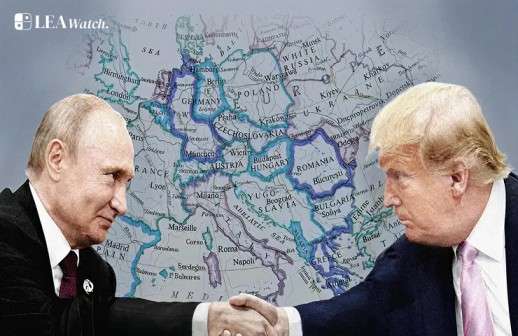The upcoming meeting between the U.S. President Donald Trump and Russian President Vladimir Putin, scheduled to be held in Alaska, marks a turning point in the ongoing Russia-Ukraine conflict and signals potential shifts in global geopolitical dynamics. This summit is being closely noted, particularly by European nations, which are caught between cautious hope and deep apprehension about the potential outcomes. This article provides an in-depth analysis of the complexities surrounding the summit, the European concerns about the prospects of U.S. acceptance of Russia’s territorial gains in Ukraine, and the possible benefits this accord could bring after the summit.
Trump – Putin – Alaska
Alaska is not just a backdrop for the Trump-Putin summit; Once this was Russian soil until its 1867 sale to the U.S., the state sits at the nexus of their shared past and Cold War rivalry, when it served as America’s “first line of defense” against the Soviet Union. Hosting the meeting at Joint Base Elmendorf-Richardson, a former air defense hub, underscores the gravity of current U.S.-Russia tensions amid the Ukraine war.
Its geographic isolation provides protection and neutrality: breaking from the predictable optics of European capitals. For Trump and Putin it will mark a first face-to-face since the 2022 invasion, and the first of Trump’s second term, which was characterized as a “feel-out” session rather than formal negotiations. Alaska’s choice combines historical resonance, military symbolism, and diplomatic positioning to signal a deliberate combination of meaning, caution, message control, and geopolitical theatre.
European Fear: A Marginalized Role and Unilateral U.S.-Russia Deal
European capitals are gripped with anxiety over the possibility that this summit could lead to a bilateral U.S.-Russia understands that it sidelines Ukraine and the European Union from negotiations impacting European security. In part, the Europeans fear down to just how little is known about what the Kremlin has proposed in order to halt the fighting in Ukraine.
Several European diplomats and leaders have voiced objections to any peace arrangement that excludes them and Ukraine itself. German Chancellor Friedrich Merz and others have stressed that territorial decisions cannot be made without Ukraine and European input, warning that U.S.-Russia dealings “over the heads” of Europeans would be unacceptable.
Europe’s fears about Russia gaining concessions shape a unified front urging caution, inclusion, and sequencing at the Alaska summit. European leaders aim to prevent a unilateral U.S.-Russia deal that legitimizes territorial losses for Ukraine, insists on security assurances, and pressures Trump to engage with European and Ukrainian partners to ensure a durable and fair peace process. Their concerns highlight the high geopolitical stakes and the fragile balance the summit must navigate to avoid further destabilizing the region.
Benefits of a Potential U.S.-Russia Deal
Despite the fears, some analysts and proponents argue that a negotiated ceasefire and peace framework between the U.S. and Russia could yield several benefits for Ukraine, Europe, and broader global stability if crafted carefully. This summit could pave the way for a ceasefire that halts current hostilities, ending the destruction and loss of life that the conflict has wrought over four years. A well-negotiated deal might address Ukraine’s fears of future Russian aggression by ensuring it remains capable of self-defense, supported by Western arms and backed by a credible security framework.
This might include commitments to preclude Ukraine’s NATO membership while allowing EU integration, thus addressing some of Russia’s strategic concerns about encirclement. Europeans face immense pressure to continue supporting Ukraine militarily and economically, an unsustainable strain without a clear resolution in sight. A peace deal could shift some responsibilities and reduce tensions in Europe, enabling it to focus more on internal cohesion and economic recovery.
Such a deal could reopen a pathway for detente reminiscent of the post-Cold War era, with agreements on arms control (such as a renewed New START and INF Treaty), economic normalization, and reduced military deployments by the U.S. in Europe. This could allow the U.S. to reallocate resources to other pressing domestic and international issues. A settlement might include commitments to fund Ukraine’s reconstruction, potentially from frozen Russian assets, helping to rebuild war-torn areas and address humanitarian needs on both sides of the conflict zones.
Complexities and Risks
The potential benefits of a U.S.-Russia deal depend entirely on the agreement’s scope, inclusivity, and enforceability. A key danger lies in the possibility that Putin will press for maximalist terms, including formal territorial concessions from Ukraine demands Kyiv has consistently rejected as unconstitutional. President Volodymyr Zelenskyy has categorically ruled out surrendering any territory, warning that such compromises would embolden Moscow and set the stage for renewed aggression. Excluding or sidelining Kyiv from the negotiating table would undermine both the legitimacy and durability of any accord. From Europe’s standpoint, peace on the continent cannot be imposed unilaterally.
Conclusion
The Trump-Putin summit in Alaska is more than just a diplomatic meeting; it encapsulates the intense geopolitical contest over Ukraine’s future, European security, and the global order. European fears of being sidelined amid U.S.-Russia negotiations underscore the fragile state of transatlantic relations and the complex web of interests at play. Yet, if handled inclusively and strategically, the summit could set the stage for an end to active conflict, enhanced security for Ukraine and Europe, and a renewed U.S.-Russia dialogue offering broader benefits. For this to happen, negotiations must respect Ukraine’s sovereignty, involve European stakeholders, and realistically address security fears on all sides.
With stakes this high, both hope and skepticism will shape global reactions to the Alaska meeting’s outcomes, as the world watches to see if this “feel-out” session blossoms into a substantive peace process or a missed opportunity amid rising tensions. This analysis reflects the multifaceted dimensions of the upcoming summit, balancing the concerns of European allies, the aspirations of Ukraine, and the strategic interests of the U.S. and Russia in a highly volatile international landscape.

